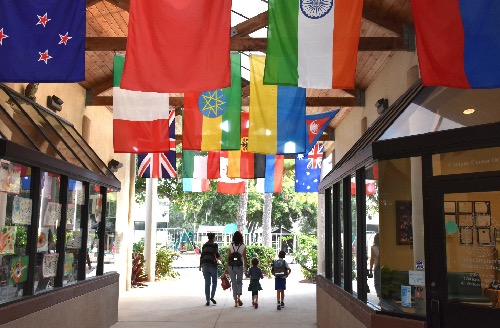
Education
Saint Stephen’s Episcopal School
If you walk down the halls of Saint Stephen’s Episcopal School, you’ll hear a host of different languages being spoken. Sure, there’s Spanish, Mandarin, Latin, and French, which are all taught there, but there’s also Russian, Swedish, Portuguese, Czech and more, thanks to their international student body. In addition to the international community, the ongoing Global Education Program also puts their students in contact with other classes from around the world. “Our school is truly to connect with the world,” says Jennifer Hambrick, an Intermediate School Spanish teacher who serves as the Director of Global Education. “We’re connected with 39 different schools in 20 different countries right now. And each year, we’re adding more to that list.” Then she smiles and says, “The Global Education program has become my baby.”
Hambrick came to Saint Stephens seven years ago and at that point, they already had a strong relationship with the Gulin Dehzi Foreign Language School in Guilin, China and the Iringa International School in Lugalo, Tanzania. These are two of the five schools that Hambrick considers their core connections, calling them “Sister Schools.” The other three Sister Schools are Holy Trinity Episcopal School in La Ceiba, Honduras, Shibuya Junior and Senior High School in Tokyo, Japan, and Colegio Nacional Monseratt in Córdoba, Argentina. Each of these Sister Schools has various teachers and classes interacting with them on a regular basis versus just a single class that partners for only a semester.
The Colegio Nacional Monseratt was a natural partner since one of the teachers there was a Saint Stephen’s exchange student a few decades back. Some of the other partnerships emerged on a project-by-project or class-by-class basis. For example, this semester, an 8th grade technology class is working on a LEGO Mindstorms robot project for a month with a school in Astana, Kazakhstan. “The goal, though,” explains Hambrick, “is to get every teacher, every class, and every student engaged in this program on some level.” And it starts early, too — Saint Stephen’s kindergartners are already connected with schools in Vancouver, Canada and Sao Paulo, Brazil.
Most of the exchanges are in English, though what happens in those exchanges varies greatly from class to class. For example, an 8th grade art class took photos of their hometown and sent them to 8th grade art students from a school in Puerto Vallarta, Mexico, who sent back photos of their hometown. “They were so beautiful,” Hambrick reports from the Saint Stephen’s art students, “that our students wondered if they were right off Google!” In daily sketches, both groups of students drew in response to the photographic inspiration. In the spring art show, the photos and accompanying sketches will be on display. Even the Saint Stephen’s PE program is seeking international partnerships. Recently, one of their teachers contacted a school in Beijing to discuss sharing PE videos so each knows what type of activities and lessons the other is doing.
Of course, Hambrick herself participates in the program. “Just today, my students wrote in Spanish in an app called Padlet about their own Halloween traditions. Then students from Argentina responded with their own observations and insights about Traditions Day, an Argentinean holiday that takes place on November 10. The goal is to learn from each other. It’s a cultural exchange and an opportunity to learn about the world. It’s also a way to break down some of the walls and misconceptions we might have about others. Through our activities, students realize that students around the world really aren’t that different from them.”
Because of time zone differences, some of the exchanges happen asynchronously where students exchange videos or texts, such as how 5th grade performing arts students sent a video to their Sister School in Tokyo showing a new Japanese hand-clapping game that they learned in class. In response, the students in Tokyo sent a video back with another hand-clapping game for our students to learn. Students from Honduras check in live weekly on Skype or through Google Hangouts. “They talk about life, work collaboratively on a project, discuss a specific academic context area, or share math strategies or an opinion on a novel,” says Hambrick. “Even when the technology doesn’t work as well as we hope, it’s still a learning opportunity. Our students watch how we, as teachers, react to challenges.”
Part of the goal is to move these exchanges from virtual to face-to-face. Interim Quest — the final week of school each year — allows for Saint Stephen’s students to undertake all manner of experiential learning. For some, it’s an international trip to one of the Sister Schools or an annual service learning trip to the Dominican Republic, though Hambrick would like to rotate in even more travel options such as Honduras, Argentina, or Tanzania so students can meet those they’ve been interacting with online. Some students, though, remain closer to home and participate in activities such visiting potential college choices or taking a weeklong class in yoga, cooking, game design, or magic.
The real value of the Global Education Program is to give students the opportunity to learn from and with others. “Limiting our students to the four walls of the classroom is a disservice,” says Hambrick. “Considering how connected the world is, you have to know how to get along with others, how to navigate discussions with people with different cultures, religions, and backgrounds. Having practiced this, it helps our students understand why people do the things they do, and it helps our students know how to respond.”
Ultimately, it makes us all more culturally sensitive and appreciative of our differences. In short, she adds, it’s programs like this that make the world a better place.
For more information on Saint Stephen’s Episcopal School, please visit saintstephens.org or call 941.746.2121.




You must be logged in to post a comment Login